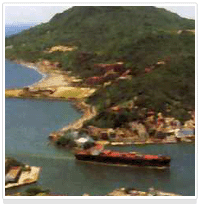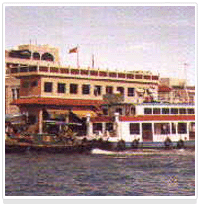.gif)
Ups and downs of the district developed earliest in Kaohsiung
Gushan District, named after the mountain because of the drums. Originally, Takaoshan (Takao Hill) was the settlement of Makatao Tribe, also known as Takau (meaning bamboo) Tribe, which was a branch tribe of Pingpu Tribe. Takaoshan was also pronounced as Takaoshe or Dagushe in its transliteration. In 1923, Governor Den Kenjiro climbed up Takaoshan to celebrate the birthday of the Japanese Prince Hirohito of that time, and then renamed the hill as Shoushan up to now.
During the period that Taiwan was ruled by Zheng Cheng-gong in Ming Dynasty, this district was subordinated to Wannian County. After Taiwan was occupied by the Manchurians in Qing Dynasty, the district was subordinated to Singlong Village and Dajhuciao Village, Fongshan County, Taiwan Prefecture, Fujian Province. In the early years of the Japanese colonial period, due to frequent alteration of local administrative districts, this district was successively subordinated to Fongshan Branch Office of Tainan County, Takao Branch Office of Fongshan County, and Takao Branch Office of Tainan County. Upon establishment of Kaohsiung State in 1920, this district was subordinated to Kaohsiung Street and Zuoying Village in Kaohsiung Region. In 1944, the district was subordinated to 7 District Offices of Kaohsiung City, namely Tamachi , Shou -cho, Yamashita-cho , Minato -machi , new coast -cho, cho boat whistle and Neiwei. After World War II, these 7 District Offices were merged as the 9th District of Kaohsiung City, which was later on renamed as Gushan District.

During the Japanese colonial period, Gushan area had two coastal railways with access to commercial port, fishing port and fish market. This kind of railway with access to fishing port was called Hamasen in Japanese. At that time local citizens pronounced this word as “Hamasing” in Fujianese. Owing to establishment of Kaohsiung Harbor and the old Kaohsiung Railway Station, Hamasen became the main hub of water and land transportation of that time, as well as the political, economic and cultural center of Kaohsiung City. Gushan District was also the pioneer district stepping to modernization. Nevertheless, as the hinterland area was too insufficient for use, and after successive migration of Kaohsiung Railway Station and fish market, the prosperity of Hamasen disappeared gradually.
With an area of 14.7523 square kilometers, Gushan District is long from the north to the south, and narrow from the east to the west. Its eastern side has Bo-ai Road and Zuoying District in the north, and has Lover River and Sanmin District in the south, connecting with the coastal railway and Yancheng District by the side of Gushan 1st and 2nd Roads. It borders Takaoshan (Shoushan, Chaishan) and Taiwan Strait to the west, borders Kaohsiung Harbor and the opposite shore’s Cijin District to the south, and borders Yucheng Road, Dongmen Road, Trunk Line Railway and Zuoying District to the north.
Extremely Good Location for Being in Front of a Hill and Facing the Sea
The inner harbor of Kaohsiung Harbor at the southern end of Gushan District has a vast space to make it become a natural good harbor, which has long been a hub of prosperity with big vessels sailing in and out frequently. Besides, the main range and sub-ranges of Shoushan have formed an absolutely good geographical environment that the district is in front of a hill and faces the sea. In addition, Gushan District was born to develop industries and fishing industry, and becomes a significant spot of international trade.

Nostalgia and Pensiveness for Tourism
In recent years, Kaohsiung City Government step by step increased more grassland by building Neiweipi Cultural Park, Shaochuantou Park and Aouzihdi Forest Park. In addition to Shoushan that covers almost the entire district, Gushan District has become the best outdoor site for Kaohsiung citizens to have recreational and sports activities, and to get close to the nature. As from 2011, Shoushan Park was even planned to be included in the area of Shoushan National Nature Park, which is also the first national nature park in Taiwan.